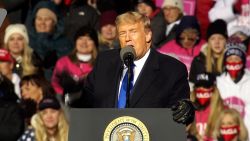White House Press Secretary Sarah Sanders seized on a misleading video apparently first posted by a far-right personality associated with fringe media organization InfoWars as a basis for indefinitely suspending the press credentials of CNN’s chief White House correspondent.
On Wednesday evening, Sanders released a statement announcing that the White House had revoked the hard pass — a credential that permits speedy entry to the White House grounds —held by CNN’s chief White House correspondent, Jim Acosta.
In the statement, Sanders falsely accused Acosta of “placing his hands” on a White House intern as she attempted to aggressively remove the microphone from his hands during a contentious press conference exchange with President Donald Trump.
Later that night, Sanders said in a tweet that the White House stood by its decision to revoke Acosta’s credentials, writing, “We will not tolerate the inappropriate behavior clearly documented in this video.”
But the video she was referring to, which was included in her tweet, didn’t come directly from one of the many cameras that had been at the press conference. Instead, it appeared to have come from Paul Joseph Watson, an editor-at-large for InfoWars, a media organization known for peddling conspiracy theories and hateful content. Such behavior resulted in InfoWars being banned earlier this year by most major social media platforms.
Moreover, it did not accurately portray what happened — it appears to show Acosta’s arm moving in a downward motion towards the intern’s faster than it actually did.
It’s unclear exactly where Sanders first saw the video or where she got it from. When she was asked on Thursday about the video and the misleading way it portrayed the incident, Sanders said, according to a White House pool report, “The question is did the reporter make contact or not? The video is clear, he did. We stand by our statement.”
CNN emailed Sanders later Thursday and asked her how the video came to her attention and whether she was aware of Watson’s background and whether she had vetted the video herself before posting it. She referred CNN back to the statement.
On Twitter, Watson strongly denied having edited the video in a deliberately deceptive fashion. Watson said that the only editing he did was to zoom in on the area around Acosta’s hand.
Watson did provide a clue as to how the video may have inadvertently come to show a misleading version of the incident, however. He said that the basis for the video he posted was not raw footage or even a clip taken directly from a network. Instead, Watson said, he had downloaded a GIF, edited it, and exported the final product as a video.
A GIF is a media file that compresses video by removing a significant number of frames from it. It allows individuals to show moving images without uploading large files.
It’s possible that the processes and technology involved in creating a GIF, downloading that GIF, editing it as a video and re-uploading it could have created the discrepancy between what the video Sanders posted shows and what the original video from the press conference clearly showed.
Whatever happened, the White House press secretary tweeted from her official account a misleading video to justify the punishment of a journalist, and sparked a debate over which video should be believed. That has people who monitor disinformation online, who have worried about the impending arrival of technology that will be able to seamlessly alter video to create the impression that people are saying or doing things they haven’t done, very concerned.
It’s widely expected that internet trolls, partisans and perhaps even rogue states will ultimately seize on sophisticated video manipulation to advance their causes. But the fact that the spokesperson for the President of the United States tweeted a misleading video and then stood by it underscored the danger and wide-reaching impact of the possible information wars.
In a Thursday afternoon statement, Whitney Shefte, president of the White House News Photographers Association, said, “As visual journalists, we know that manipulating images is manipulating truth. It’s deceptive, dangerous and unethical. Knowingly sharing manipulated images is equally problematic, particularly when the person sharing them is a representative of our country’s highest office with vast influence over public opinion.”
At BuzzFeed, Charlie Warzel summed up those concerns, writing, “The entire ordeal is a near-perfect example of a scenario disinformation experts have predicted and warned of, where the very threat of video manipulation can lead to a blurring of reality.”





















